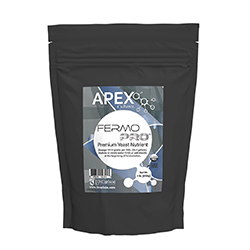The Lifespan of Yeast Nutrient: A Crucial Factor in Fermentation
Posted by Matteo Lahm on 29th Jan 2025
While organizing your workshop, you find a bag of yeast nutrient you didn’t know you had. You might think that now you can wait to buy more because you have enough for the new batch you are planning. But then your excitement dwindles. It occurs to you that you don’t know how long you’ve have had it. Then you notice the bag was open. If your next thought would be that it is better to toss it, you’d be right. Understanding the shelf life of yeast nutrient and proper storage are critical aspects of fermentation. This seemingly insignificant ingredient plays a vital role in your process, and its quality can significantly impact your results.
Yeast nutrient, as the name suggests, is food for yeast. It's a blend of vitamins, minerals, and other compounds that help yeast cells grow and multiply. But like any other food, it doesn't last forever. So, how long does yeast nutrient last, and how should you store it? Let's delve into the details.
The Shelf Life of Yeast Nutrient
Typically, a well-stored yeast nutrient can last up to two years. However, this timeline isn't set in stone. Factors like storage conditions and exposure to air can shorten its lifespan. Over time, these components can degrade, especially when exposed to unfavorable conditions.
For instance, exposure to air can lead to oxidation of certain elements in the yeast nutrient. Oxidation is a chemical reaction that can change the properties of these elements, reducing their effectiveness. This is similar to how a sliced apple turns brown when left out in the open.
Moreover, moisture can also affect the yeast nutrient. When exposed to moisture, some minerals and vitamins can dissolve, change their structure, or even react with other elements, leading to a loss of potency.
High temperatures can also be detrimental. Heat can speed up chemical reactions, leading to faster degradation of the nutrient components.
In essence, when yeast nutrient gets too old or is stored improperly, it can eventually become almost useless. The nutrient will not be able to provide the yeast with the necessary elements it needs for optimal growth and fermentation, which can lead to some very unwanted outcomes.
It is a good idea to write on the yeast nutrient bag the date that you received it so that you will know exactly how old it is.
Storage
Store your yeast nutrient in a cool, dry place away from direct sunlight and in a tightly sealed container. Even in the right conditions it will not last so imagine what happens in the wrong conditions. It will lose potency over time regardless so bad storage just makes matters worse. If you use old and/or improperly stored nutrient, yeast cells may struggle to metabolize sugars into alcohol, leading to a sluggish or stuck fermentation.
Potential Off-Flavors and Other Problems
Aged or degraded yeast nutrient can indeed produce off-flavors in your beer or wine. These can range from a mild, almost imperceptible change in taste, to a distinct, unpleasant flavor that ruins the entire batch. But what exactly causes these off-flavors, and how would you describe them?
When yeast cells don't get the nutrients they need, they become stressed. This stress can cause the yeast to alter its metabolic pathways, leading to the production of unwanted byproducts. These byproducts are often the culprits behind the off-flavors.
One common off-flavor caused by yeast stress is a taste described as 'cidery' or 'winey.' This flavor is often the result of yeast producing too much acetaldehyde, a compound that is usually further metabolized into alcohol. However, when yeast is stressed, this process can be disrupted, leading to an excess of acetaldehyde.
Another potential off-flavor is a 'buttery' or 'butterscotch' taste, caused by an excess of a compound called diacetyl. Under normal conditions, yeast cells absorb diacetyl and convert it into less flavor-active compounds. But when yeast is stressed and not functioning optimally, this process can be hindered, leading to a buildup of diacetyl.
A 'sulfur' or 'rotten egg' smell can also occur when yeast is under stress. This is due to the production of hydrogen sulfide, a gas that yeast cells can produce when they're not getting the nutrients they need.
Some of these off-flavors can be quite overpowering. The worst of which can make your wine or beer undrinkable.
In conclusion, the shelf life of yeast nutrient is a factor that brewers and winemakers should not overlook. Proper storage can extend its lifespan, while using fresh, high-quality nutrient can ensure a smooth fermentation and a tasty final product. So, remember, yeast nutrient isn't just an ingredient; it's a key player in the art of brewing and winemaking. It is like kicker on a football team. That extra point really matters. Cheers!



